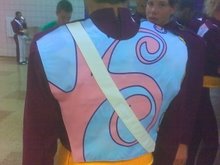Tuning, a quick survey of different techniques...
This came up in a DCP post and I thought it would be good to kind of expand upon this idea....
From my point of view there are three different methods to approach tuning - electronically, aurally, and mechanically. I will survey each one as a separate method, however they are not exclusive methodologies - meaning a combination of the three can be effective as well.
Electronically
This approach seeks to tune the instruments first using an electronic tuner. The tuning note is generally a concert B-flat, however some people swear tuning to a concert F is better. Personally, since on a brass instrument the inherent tuning difference between an F and a B flat is so insignificant, I like the getting the B flat in tune because it is higher and generally right in the middle of the register for players. F is generally a little easier to bend, so it is harder to get a true read on where the student is placing the note. A student may be playing with a loose embouchure, causing the F to read as flat...the student pushes the tuning slide in to adjust and throws other partials extremely sharp. when the student tightens the embouchure to reach higher notes, he is suddenly badly out of tune with the rest of the ensemble. A popular method to minimize the "bending" effect is to have the students play up to the tuning note starting on F. They play "F-G-A-Bflat", holding the B flat at the top to be tuned. This is a more natural and realistic approach to the note and can sometimes help in getting a true read of a players tuning.
Electronic tuning has the advantage of being fairly accurate and immune against human error. Sure embouchure problems might throw student's pitch out of whack, however that is more a problem of playing fundamentals than it is tuning. It is also quick, speed being limited to the number of tuners available at the time. Another advantage is that no real training is required of the people using the tuner - just a simple knowledge of what to do when the tuner reads a certain way.
The disadvantage of electronic tuning is that students become dependent upon the tuners to play in tune. Using this as the only tuning method in a technique program is not recommended. Students should have an understanding of a basic concept of playing "in tune" and have advanced listening skills before this method can be totally effective. If you are using this method, take the time to make sure students know exactly what is going on and the reasoning behind how to adjust for tuning.
Aural tuning
This is the approach championed by The Cavaliers recently. It involves no electronic tuners and is focused on developing the listening skills of the performers. Tuning notes often originate from the bass voices and work their way upwards to the high trumpets and piccolos. The goal is to listen to the tuning note and attempt to match the sound, not only in pitch, but in quality as well. Often two players who can register as in tune by an electronic tuner can sound out of tune because the quality and timbre of their sounds differ. The reason for this perceived difference is while the fundamental note is in tune, the overtones that create timbre are not. This can be fixed with some individual work with an advanced electronic tuner that displays overtones, however not many programs have the time - much less the actual tuner - to spend fixing individuals. On the field, techniques that develop sound, "air and valve/key", mouthpiece buzzing/squawking, and simply listening to a pure characteristic tone can help. I run into this problem a lot with Saxophones and Trumpets. Saxes range from a very mellow, clarinet-like sound, to a harsh jazz timbre. Depending on your ensemble you may want either one. Trumpets have either a "stuffy" sound or a "bright" tone. The factors that go into these and how to fix them are many, but that is a topic for another post...
Anyway, the aural tuning method trains the performers to match their tones to to one another. This becomes useful in actual performance when they can recognize they are out of tune and respond by independently adjusting it. Performers also become more aware of the tuning tendencies of their instruments and can better anticipate when adjustments will be needed.
A good method that I use is the idea of a "tuning trio." This is a good extension exercise that uses skills from aural training to help with blend and balance. After being tuned in some fashion, three students with like instruments will face each other and play the three notes of a B flat major chord. On a signal, the students will switch and pass around the notes, the goal being to keep the sound consistent. This is quite difficult to achieve as not only do performers have to listen and be aware of tuning and timbre matching, but also be aware of their chordal responsibilities.
Mechanical tuning
This third method is definitely in the minority in terms of use. This is the method that was championed by The Blue Devils in the 90's and, more recently, by Gino Cipriani and The Cadets. The basic premise is that instruments of the same brand, using the same mouthpiece, played in the same manner, will be in tune mechanically at the same point as a function of the air temperature. This method is only applicable to bands and corps who play on instruments of the same brand, and whose mouthpieces are the same. This is very important, because different mouthpieces and bran of horn have different tuning tendencies.
What happens is the staff carefully make marks on the tuning slides of instruments a few millimeters apart. Each day,a small group of players representing each type of instrument will tune using one of the methods described above. The air temperature will be recorded as well as which mark on the tuning slide the instruments were in tune at. The rest of the ensemble will move to the mark that their instruments are in tune. After enough data is collected, the staff can make pretty good estimates on where to set the marks on the tuning slide based on the air temperature alone. From there only minor adjustments can be made on an individual basis. As with the electronic method of tuning, exclusive use of this method is not recommended as students should have an understanding of tuning on a functional level.
The advantage of this system is, while data collection takes time, once it is in place it is by far the fastest way to get a group in tune. Also, it creates consistency throughout the hornline, especially if a last second adjustment is needed. It is a lot more precise to say "move out two marks" instead of the vague statement "pull out." This method also allows for changes in air temperature in the performance venue - for instance if performing in a dome. The staff can set the hornline to be in tune at the aur temperature inside, instead of having tuning go bad because they tuned in a warmer environment.
The disadvantage of this system is it requires absolute consistency, not only in horn and mouthpiece selection, but also in the approach to playing the instrument. Every program has the goal of consistent approaches to playing, however it is up to the individual directors and staff to recognize when there are exceptions. Each player has different tuning tendencies that are discounted as part of this process. Certainly individual work and identification of a player's tendencies can happen, however it is time consuming and ever changing depending upon circumstances.
Also uncertain is how this system could work with woodwinds. I suppose one could mark the corks in a similar manner as tuning slides, but I can't speak to this as I have never seen it done.
None of these three approaches should ever be used in isolation. As educators, we should all strive to help performers understand tuning and how to play in tune, and not glance over tuning the same way we would gas up a car.. Our approach to tuning should be from a variety of angles, recognizing that students learn in very different ways. What a student sometimes cannot hear suddenly may become very clear to him after seeing the needle on a tuner, for instance. We should mix up our routines and not be afraid to try new methods.![]() drum corps ;
drum corps ; ![]() DCI ;
DCI ; ![]() marching band
marching band





1 comment:
the gino approach:
I can see how it would work with Flutes/Piccs, assuming everything were the same (brand, embouchure). But with reeds, I'm not sure. They are capable of "pulling out" (how dirrrty haha), at a variety of places on their instrument to be "in tune". I suppose, with more in depth research, it could be proven that it works there too, there is just more to consider (how old the reed is, etc.). But the same can be said about brass, as there are many slides to move in and out to achieve better intonation. So who knows.
I had heard about the old skool BD thing, but I didn't know that Cadets have been doing it too, maybe I'll learn more about it at Buccs this summer ;)
Intonation is a fascinating subject, and I'd love to learn more about it. My trumpet guy (a.k.a asst. caption head to Gino at buccs), did his doctorate paper on intonation, so I get tidbits of info from him from time to time. Its pretty awesome to see how chords change and effect tuning. I mean, as a performer its obvious how it effects you, but to know WHY and HOW really is mystifying.
keep on keepin on!
~marth
Post a Comment